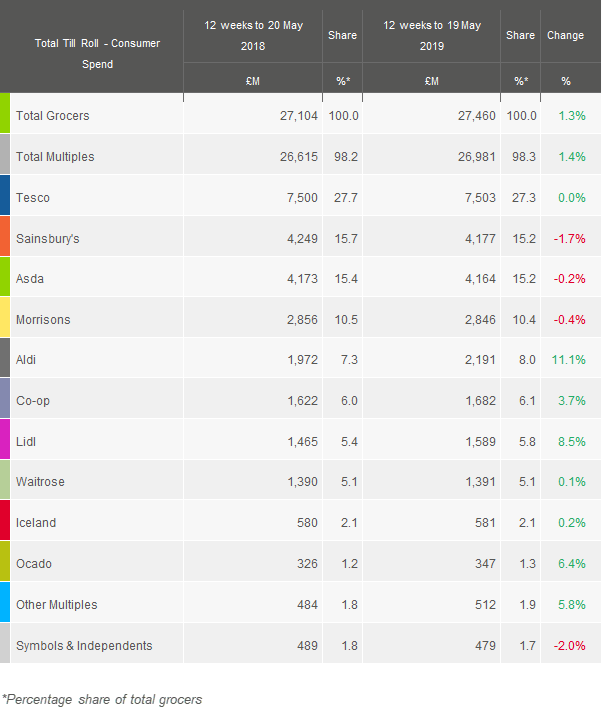Latest figures from Kantar show the grocery market grew by only 1.3% during the 12 weeks to 19 May 2019 with all the Big Four supermarket multiples suffering against tough comparatives with the same period last year which was boosted by good weather and the royal wedding.
This compared with last year’s growth of 2.7%, although the sector continued to demonstrate resilience with volume sales remaining unchanged. Kantar also highlighted that the sector should benefit from upcoming sporting events such as the two European football finals, the Cricket World Cup, and the FIFA Women’s World Cup.
While Tesco’s overall sales were flat, its performance was the strongest out of the Big Four, supported by demand for its own label ranges. Chris Hayward, consumer specialist at Kantar, commented: “Exclusively at Tesco products continue to be popular and went home in a quarter of customers’ baskets while discounts linked to the retailer’s ‘100 years of value’ campaign delivered a further boost. Looking ahead, the supermarket will be hoping the decision to make lines from its Jack’s discount arm available in store throughout May will pique customers’ interest and generate incremental sales.”
Meanwhile, Sainsbury’s sales continued to fall as it nears its 150th birthday. Hayward said: “Sainsbury’s is approaching its own anniversary a bit differently from rival Tesco – as well as reflecting on the past 150 years and including the Queen in celebrations, it is also looking forward and championing smaller brands with its Future Brands initiative. Sainsbury’s will be hoping that this strategy, combined with an increased level of promotions in recent months, will help win shoppers back.”
With the CMA ruling against their proposed merger now behind them, Asda and Sainsbury’s were neck and neck in the number two position this period as overall sales at Asda fell 0.2% despite online growth of 10.7%. Meanwhile, Morrisons also saw it sales and market share fall.
Aldi and Lidl continued their strong run and are now worth a collective £344m more than this time last year with combined record market share of 13.8%. Hayward commented: “The discounters continue to attract customers with nearly one million more households visiting Aldi compared with last year and an additional 630,000 shopping at Lidl. Around 75% of growth at both supermarkets is coming from the ambient and chilled aisles as people opt for value in a greater proportion of their basket.”
Aside from Aldi and Lidl, the Co-op delivered the strongest bricks & mortar sales growth of 3.7%, buoyed by new promotions like its frozen meal deal.
Waitrose experienced marginal growth of 0.1% during the period. Its new ‘Good Health’ range was one of the fastest growing own label lines across the major retailers, with sales totalling £13.4m. Kantar suggested that the supermarket’s large proportion of AB customers is driving this growth as they increasingly look to make healthier choices.
Meanwhile, Kantar’s data showed that grocery inflation stood at 1.2% during the period with prices rising fastest in markets such as cola, dog food and crisps, while falling in instant coffee, bacon and nuts.

NAM Implications:
- This realistic update does not read well especially for branded NAMs.
- The issue for all stakeholders is whether the major mults can recover historic market shares…
- …given the continuing march of the discounters and online in flatline demand.
- Best budget for the mults ‘as is’…
- …and focus on ways of optimising the discounters and online.




